The Fate of the 1622 Fleet: Nuestra Señora de Atocha
The New World, Gold, and Spain

Captain Alonso Turillo de Yebra, master of the newly formed minting houses in Colombia, was so anxious to show his king samples of his gold production that he personally booked passage on the official treasure fleet of 1622 headed for Havana... and then Spain. The last vessels of the Terra Firma Fleet were leaving the Caribbean well into hurricane season as they pulled out of Cartagena on August 3rd. The balance of the Marques de Cadereita's flota, the New Spain Fleet, had gone on ahead to Havana, where they were to join up with the convoy from South America for the return to Cadiz. Assembling the combined armada in Cuba took until September 4th, 1622, in the peak period for tropical Atlantic storms.
Cadereita boarded the Nuestra Señora de la Candelaria, his capitana, and lead as the convoy of twenty eight galleons and merchant vessels. The ships departed Havana the morning of the fourth. Nuestra Señora de Atocha, the almiranta of the fleet, brought up the rear of the column. The galleons Santa Margarita and Nuestra Señora del Rosario, both loaded with treasures, were positioned close to the Atocha in this ocean-going fleet as it snaked its way north toward los martires, the Florida Keys.
The Storm

Conditions were favorable for the convoy until the morning of September 5th, when the ships encountered gales which dispersed the fleet, each ship fending for itself. Half-way through the night, a hurricane from the south roared at the tail end of the column, driving several of the helpless vessels toward the martires ... and their destruction. By September 6th, the full force of the tempest had been felt, with some ships sinking in the deep water and some being demolished against reef and shore. Cadereita's Candelaria, and others farther north and west at the time, were damaged to varying degrees, but they stayed afloat and eventually found shelter in Havana when the storm had passed.
The Aftermath

The Rosario was blown onto a remote key in the archipelago, the Santa Margarita disintegrated against a sand bank to the east, and the Atocha sank on a patch reef in fifty-five feet of water south and a little east of the Margarita's position, her masts remaining visible above water for a long time. In the chaos that followed, survivors from the Rosario took refuge on the rocky islet that the ship collided with. The Santa Cruz, a small Cuban merchant ship from the convoy, survived and had some mobility, maneuvering near the Margarita and rescuing 68 of her crew. The Santa Cruz then sailed to where the Atocha's mizzenmast was refuge for five of its crew and saved them. The loss in human life at this scene was painfully apparent: 143 persons aboard Santa Margarita had perished during the storm, and 260 passengers and crew were trapped in Atocha's hold several fathoms below the surface of the sea. All told, the casualties of this calamity would amount to about 600 souls.

